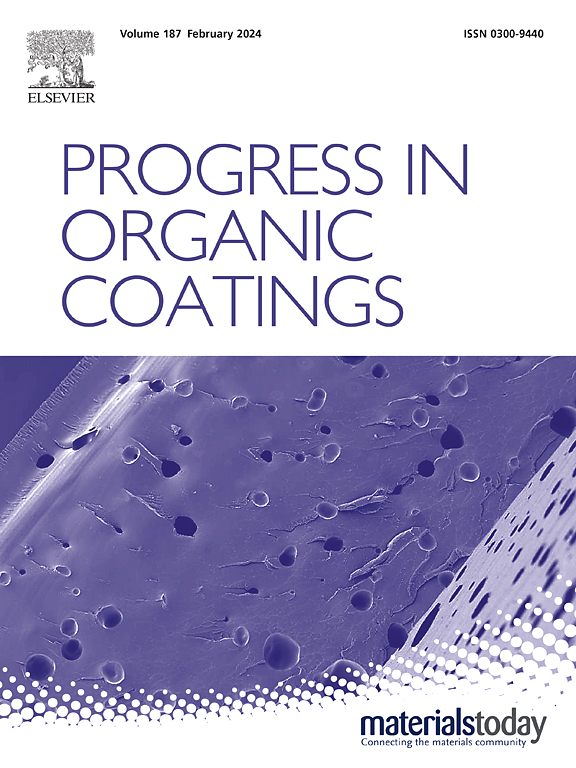Partially fluorinated derivatives as a powerful tool for the restoration of blanched easel paintings
IF 6.5
2区 材料科学
Q1 CHEMISTRY, APPLIED
引用次数: 0
Abstract
The use of specific coatings has considerable importance in the field of cultural heritage conservation. The blanching of easel paintings is a worrying phenomenon induced by excessive humidity and porous structures, often obscuring the image beneath a white haze. The research available in the literature describing solutions to solve this problem is extremely limited. In this research, new oligoamides containing hydroxyl and/or amino groups, i.e., partially fluorinated oligodiethylene succinamide-l-tartaramide (DSTF) and oligodiethylene succinamide (DSF), were designed to give high affinity with the polar components present in paint films through non-covalent interactions, and have reduced environmental impact compared to the previously proposed perfluoroamide (DC6G900). These innovative products represent one of the few solutions proposed for this area of application. Their syntheses were carried out via condensation and subsequently ring-opening reaction of the short-fluorinated epoxy compound, 3-perfluorohexyl-1,2-epoxypropane (EC6F). The short-fluorinated chain has a dual effect; it improves surface performance by lowering surface tension while simultaneously reducing environmental impact compared to the perfluoro source previously used. The performance of the two new fluorinated oligoamides (DSTF, DSF) on blanched easel paintings was investigated through a series of tests, from the macroscopic to the microscopic scale. The new fluorinated oligoamides dramatically decreased the luminance value (almost restoring the value of the un-blanched sample) in comparison with the other tested compounds (ESTF, ESF, DF and DC6G900 as a reference). This result is ascribed to the ability of the compounds to fill the pores of the blanched surfaces, as demonstrated by the morphological study using a Field emission gun - Scanning electron microscopy. In addition, preliminary investigations showed that all the tested compounds, can be removed from the treated mock-ups using 2-propanol or 2,2,2-trifluoroethanol, giving promising results concerning the removal of the restoration treatments.
部分氟化衍生物作为一种强大的工具,以恢复漂白的架上画
特殊涂料的使用在文化遗产保护领域具有相当重要的意义。架上画的褪色是一种令人担忧的现象,这种现象是由过度的湿度和多孔结构引起的,通常会使图像在白色的雾霾下变得模糊。文献中描述解决这一问题的方法的研究是非常有限的。在这项研究中,新的含有羟基和/或氨基的低聚酰胺,即部分氟化低聚二乙烯琥珀酰胺-l-tartaramide (DSTF)和低聚二乙烯琥珀酰胺(DSF),通过非共价相互作用与漆膜中的极性组分具有高亲和力,并且与先前提出的全氟酰胺(DC6G900)相比,减少了对环境的影响。这些创新产品代表了为该应用领域提出的少数解决方案之一。它们的合成是通过短氟化环氧化合物3-全氟己基-1,2-环氧丙烷(EC6F)的缩合和随后的开环反应进行的。短氟化链具有双重作用;与以前使用的全氟源相比,它通过降低表面张力来改善表面性能,同时减少对环境的影响。通过从宏观到微观的一系列试验,研究了两种新型氟化低聚酰胺(DSTF、DSF)在漂白架上绘画上的性能。与其他测试化合物(以ESTF、ESF、DF和DC6G900为参照)相比,新型氟化低聚酰胺显著降低了亮度值(几乎恢复了未漂白样品的亮度值)。这一结果归因于化合物填充漂白表面孔隙的能力,正如使用场发射枪-扫描电子显微镜进行的形态学研究所证明的那样。此外,初步调查表明,使用2-丙醇或2,2,2-三氟乙醇可以从处理过的模型中去除所有测试的化合物,这在去除修复处理方面给出了有希望的结果。
本文章由计算机程序翻译,如有差异,请以英文原文为准。
求助全文
约1分钟内获得全文
求助全文
来源期刊

Progress in Organic Coatings
工程技术-材料科学:膜
CiteScore
11.40
自引率
15.20%
发文量
577
审稿时长
48 days
期刊介绍:
The aim of this international journal is to analyse and publicise the progress and current state of knowledge in the field of organic coatings and related materials. The Editors and the Editorial Board members will solicit both review and research papers from academic and industrial scientists who are actively engaged in research and development or, in the case of review papers, have extensive experience in the subject to be reviewed. Unsolicited manuscripts will be accepted if they meet the journal''s requirements. The journal publishes papers dealing with such subjects as:
• Chemical, physical and technological properties of organic coatings and related materials
• Problems and methods of preparation, manufacture and application of these materials
• Performance, testing and analysis.
 求助内容:
求助内容: 应助结果提醒方式:
应助结果提醒方式:


